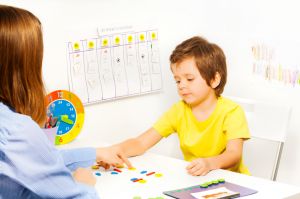 Most of us have experienced the 2-year-old who, after being told they can’t do or have something, proceeds to hit their head against the wall or drop to the floor kicking and screaming.
Most of us have experienced the 2-year-old who, after being told they can’t do or have something, proceeds to hit their head against the wall or drop to the floor kicking and screaming.
Caregivers will usually respond to this in one of two ways: giving the child access to the item or activity in an attempt to stop the problem behavior, or standing firm while comforting their child until the behavior stops.
There’s a natural sense and hope that, as the toddler develops, so will his language skills and, therefore, it’ll be easier to have a conversation about rules and expectations.
But what if your child never develops the necessary building blocks for communication?
Many parents of children with autism and other developmental disabilities face this problem. Since deficits in social development are one of the hallmarks of autism spectrum disorder, it only makes sense that not being able to communicate appropriately could result in the child engaging in an unsafe behavior.
While children with developmental disabilities can be limited in how well they can communicate, we can still work with them on alternative communication methods.
Here are some ways to teach some of these skills:
- Identify the pattern of problem behavior and the variables controlling it: If a non-verbal child wants attention or an item, and receives any of these things each time he hurts himself or others, then he will continue that behavior as a way to get his needs met. This is his unique way of “communicating” his needs. The pattern here would be that the child wants a snack and is unsure how to get it, so he proceeds to hit his mother out of frustration. The mother gives him what he wants, and thus the child learns that he needs to hit his mom each time he wants a snack. As a caregiver, it’s important to identify what happens before and after the behavior, and break any variables that reinforce those behaviors.
- Teach alternative behaviors: So you’ve identified a pattern. What now? Simply saying “No” or “Stop doing that!” isn’t enough, and is usually counterproductive. Individuals with developmental disabilities don’t need to be taught what NOT to do; they need to learn what TO DO to get their needs met. It’s key to teach socially acceptable behaviors to replace problematic ones; sometimes, this involves teaching communication strategies.
- Finding a communication strategy that works: It’s important to determine what type of communication style your loved one can use. It’s equally important to practice using those strategies until they reliably use it in place of a problem behavior. When you decide on a communication style (or two) that can work, you’ll have to be vigilant in teaching the appropriate behavior when a problem one occurs before giving them access to whatever they want. Using the previous example, if the child hits his mother in an attempt to get a snack when they’ve been practicing using a picture board, the mother would prompt him to point to the picture of the snack before giving him what he wants.
Idenifying a patter, teaching alternative behaviors, and finding the right communication strategy takes time and pracitce. Be patient. Eventually, when the mother begins to show that the hitting does not produce a wanted item and the picture board does, the child may use the strategy that more readily reinforces his attempt to get his needs met.
Read on for part 2 of this blog post!
Tom Flis, MS, BCBA, LBA, LCPC, is a senior behavior specialist with Sheppard Pratt Health System, working on the Adult Neuropsychiatric Unit, which offers specialty care for adults with developmental and/or psychotic disorders. Tom is a board certified and licensed behavior analyst and a licensed clinical professional counselor who has more than 12 years of experience working with children and adults diagnosed with a developmental disability.